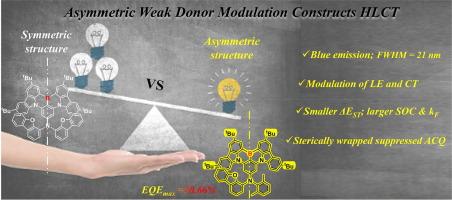有机发光二极管中B, n嵌入发射体杂化局域和电荷转移态的控制
IF 13.2
1区 工程技术
Q1 ENGINEERING, CHEMICAL
引用次数: 0
摘要
限制多共振热激活延迟荧光(MR-TADF)分子发光效率的主要因素是缓慢的反向系统间交叉(RISC)过程。本文提出了一种不对称弱电子供体调制策略,成功地将杂化局部电荷转移(HLCT)态引入到具有1,3-二(3,6-二叔丁基咔唑-9-基)苯硼核(DtCzB)的硼/氮基MR-TADF材料中。得益于RISC工艺的增强,新合成的DtCzB- sfn分子具有快速的荧光速率常数(kF >; 108 s−1)和高自旋轨道耦合参数(SOC: <S1|ĤSOC|T2 >; 为0.9204 cm−1),均明显高于其他基于DtCzB核心的MR-TADF材料。此外,利用DtCzB-SFN作为发射极的天蓝有机发光二极管(OLED)的最大外量子效率(EQEmax)达到30.7 %。此外,由于DtCzB-SFN的立体包封效应得到改善,可以有效抑制聚集引起的猝灭,因此即使在高掺杂浓度下,器件也能保持高效率。因此,在MR-TADF发光系统中控制HLCT状态的策略为开发高性能oled提供了一种有前途的方法。本文章由计算机程序翻译,如有差异,请以英文原文为准。

Governing hybridized local and Charge-Transfer state in B,N-Embedded emitters for OLEDs
The primary factor limiting the luminous efficiency of multi-resonant thermally activated delayed fluorescence (MR-TADF) molecules is the slow reverse intersystem crossing (RISC) process. This work proposes an asymmetric weak electron donor modulation strategy which successfully introduces hybridized local-charge transfer (HLCT) states into the boron/nitrogen based MR-TADF materials with 1,3-bis(3,6-di-tert-butylcarbazol-9-yl)benzeneboron core (DtCzB). Benefiting from the enhancement of RISC process, the newly synthesized molecule DtCzB-SFN exhibits a fast fluorescence rate constant (kF > 108 s−1) and high spin–orbit coupling parameter (SOC: <S1|ĤSOC|T2 > is 0.9204 cm−1), both notably higher than other MR-TADF materials based on the DtCzB core. Moreover, the maximum external quantum efficiency (EQEmax) of the sky blue organic light-emitting diode (OLED) utiziling DtCzB-SFN as emitter reaches 30.7 %. Additionally, due to the improved steric encapsulation effect in DtCzB-SFN, which can effectively suppress aggregation-caused quenching, the device maintains high efficiency even at high doping concentrations. Therefore, the strategy of goverining HLCT states in the MR-TADF luminescence system offers a promising approach for developing high-performance OLEDs.
求助全文
通过发布文献求助,成功后即可免费获取论文全文。
去求助
来源期刊

Chemical Engineering Journal
工程技术-工程:化工
CiteScore
21.70
自引率
9.30%
发文量
6781
审稿时长
2.4 months
期刊介绍:
The Chemical Engineering Journal is an international research journal that invites contributions of original and novel fundamental research. It aims to provide an international platform for presenting original fundamental research, interpretative reviews, and discussions on new developments in chemical engineering. The journal welcomes papers that describe novel theory and its practical application, as well as those that demonstrate the transfer of techniques from other disciplines. It also welcomes reports on carefully conducted experimental work that is soundly interpreted. The main focus of the journal is on original and rigorous research results that have broad significance. The Catalysis section within the Chemical Engineering Journal focuses specifically on Experimental and Theoretical studies in the fields of heterogeneous catalysis, molecular catalysis, and biocatalysis. These studies have industrial impact on various sectors such as chemicals, energy, materials, foods, healthcare, and environmental protection.
 求助内容:
求助内容: 应助结果提醒方式:
应助结果提醒方式:


